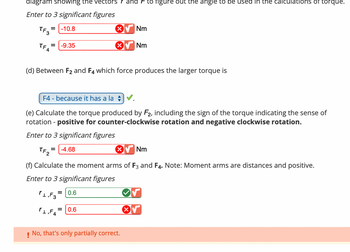(c) Calculate the torques produced by and F4, including the sign of the torque indicating the sense of rotation, positive for counter-clockwise rotation and negative clockwise rotation. Help: When using the formula for torque, the angle is between the tails of which two vectors? Draw a diagram showing the vectors and to figure out the angle to be used in the calculations of torque. Enter to 3 significant figures TF3 TFA = = HBetween 5. and which force produces therger or Pis TF2 (e) Calculate the torque produced by F2, including the sign of the torque indicating the sense of rotation - positive for counter-clockwise rotation and negative clockwise rotation. Enter to 3 significant figures = = 1,F3 Nm Nm (f) Calculate the moment arms of F3 and F4. Note: Moment arms are distances and positive. Enter to 3 significant figures ₁,FA = Nm m m
Rigid Body
A rigid body is an object which does not change its shape or undergo any significant deformation due to an external force or movement. Mathematically speaking, the distance between any two points inside the body doesn't change in any situation.
Rigid Body Dynamics
Rigid bodies are defined as inelastic shapes with negligible deformation, giving them an unchanging center of mass. It is also generally assumed that the mass of a rigid body is uniformly distributed. This property of rigid bodies comes in handy when we deal with concepts like momentum, angular momentum, force and torque. The study of these properties – viz., force, torque, momentum, and angular momentum – of a rigid body, is collectively known as rigid body dynamics (RBD).


Trending now
This is a popular solution!
Step by step
Solved in 4 steps with 15 images










